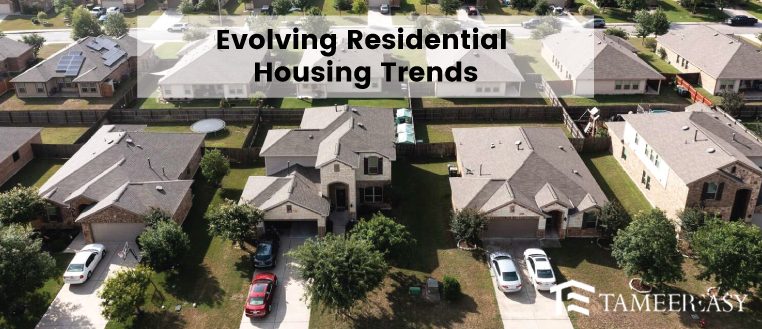Residential housing is undergoing ongoing change due to altering societal choices, advanced technology, and environmental concerns. The idea of “home” is evolving as we move through the twenty-first century.
Visit TameerEasy Store to Purchase Quality Construction Items
This article examines major residential housing developments that alter our lives, from cutting-edge architecture to eco-friendly living options.
Trend 1: Open and Flexible Floor Plans
The trend to open and flexible floor layouts is one of the most obvious changes in residential housing. Interconnected areas that promote fluidity and adaptability are replacing traditional segregated floor tiling plans. Homeowners seek spaces encouraging socialisation, making the most of natural light, and supporting multipurpose living.
This trend is best illustrated by open kitchens that flow naturally into living and dining spaces, creating spaces that can be used for family time and entertaining.
Trend 2: Smart Home Technology Integration
As smart home technology develops, homes become sophisticated living environments. The efficiency and convenience of technology, like voice-controlled assistants, smart lighting, and security systems, is being embraced by homeowners.
Residents can now remotely control and monitor their homes thanks to smart thermostats, energy-efficient appliances, and even fully integrated home automation systems, which improve comfort and security.
Trend 3: Sustainable and Eco-Friendly Designs
Modern residential housing trends have made sustainability a pillar. Homeowners are looking for energy-efficient designs, environmentally friendly materials, and renewable energy sources as they become more aware of their environmental impact. Designs use solar panels, rainwater harvesting systems, and passive heating and cooling techniques to reduce carbon footprints and utility costs.
Trend 4: Multigenerational Living Spaces
Multigenerational living arrangements are becoming more common due to shifting family dynamics and financial factors. Homes with separate living quarters or flexible floor plans that may house extended families are becoming increasingly common. This pattern shows the trend toward sharing responsibility and strengthening family ties.
Trend 5: Wellness-Focused Amenities
The value of well-being is now included in house design and daily routines. Residential housing trends are adopting wellness-focused facilities, like in-home gyms, quiet meditation rooms, and designated relaxation locations.
Biophilic design, which incorporates natural elements into spaces, is becoming more popular because it fosters a connection with nature and mental health.
Trend 6: Compact and Urban Living Solutions
The need for effective, space-maximizing housing solutions increases along with the growth of urban populations. Tiny dwellings, micro-apartments, and compact housing are becoming more popular in cities with limited space. These layouts emphasise space-efficient living while maintaining comfort and style.
Trend 7: Aging-in-Place Features
As the population ages, ageing-in-place design features are showing up more frequently. Homeowners are exploring housing solutions to age safely and comfortably in their homes. To adapt to changing needs, features like zero-step entry, wider corridors, and accessible bathrooms are being incorporated into designs.
Trend 8: Customization and Personalization
Personalisation is a driving element behind residential dwelling trends in this age of self-expression. Homeowners desire environments that are a reflection of their unique interests and styles. Custom cabinets, distinctive finishes, and specially created furniture are becoming more popular as individuals want to make spaces that reflect their identities.
Conclusion
Residential housing trends reflect how our values, goals, and lives change. These trends alter how we think about and use our living spaces, from open and adaptable layouts to sustainable living options and enhanced technological integration.
Making houses that meet our basic requirements and promote connection, well-being, and a sense of belonging is a challenge as we move forward. By embracing these trends, we may create a future where homes are more than simply buildings and serve as significant sanctuaries that improve our lives.


